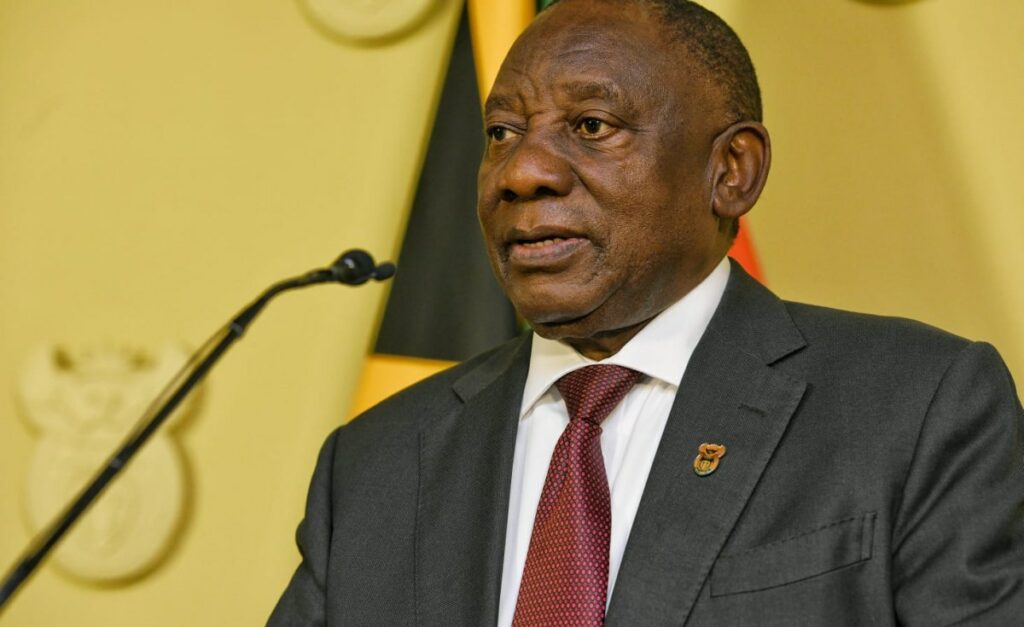President Cyril Ramaphosa has named his cabinet after several weeks of intense negotiations between the ANC and the 10 other parties that form South Africa’s government of national unity.
South Africa’s President Cyril Ramaphosa unveiled his long-awaited new cabinet on Sunday evening after his African National Congress (ANC) — which gained the most votes in recent elections but lost its majority — and his coaltion partners agreed on how to share out the 32 cabinet positions.
Of the 11 parties in the government of national unity, seven are represented in the cabinet.
Who got which ministries?
The ANC has 20 cabinet posts, including key ministries of the presidency, finance, defense, justice, police and foreign affairs.
Keeping the foreign ministry under ANC leadership will likely see the government continue its support of Palestinians and its strong criticism of Israel’s actions in Gaza.
“A smart thing in terms of the ANC and Ramaphosa is that they actually haven’t given up what one could say are the critical ministries like the presidency,” explained Kealeboga Maphunye, a professor of African politics at the University of South Africa. “They retain, in my view, most of the powerful ministries.”
The Democratic Alliance (DA), the second biggest party in the coalition, has six ministerial posts. The ANC withdrew its offer of giving the pro-business DA the post of trade and industry minister last week, which stalled talks. The DA has now received the agricultural ministry instead, as well as education, communications, home affairs, environment and public works.
The other six ministries were shared out among the smaller parties. The Inkatha Freedom Party (IPF) gained two, while the Freedom Front Plus, Good Patriotic Alliance and Pan Africanist Congress of Azania received one ministerial post each.
Kealeboga Maphunye called the awarding of the ministry of traditional affairs to the IFP “a smart move on the side of President Ramaphosa because [the party] … is mostly supported by the Zulu ethnic majority in Kwa-Zulu Natal.”
Was the allocation of the ministries fair?
With only six posts, the Democratic Alliance has ended up with a smaller fraction of ministries compared to the 22% of votes it gained in the election, noted Martin Plaut, senior research fellow at the Institute of Commonwealth Studies, at the University of London.
“The ANC has got 62% of the seats in the cabinet but only got 40% of the vote,” Plaut told DW. “So, the people that really got squeezed were the Democratic Alliance. … [It’s] made a huge compromise.”
“The DA have got posts that I think they will find helpful, however,” he said pointing out that education is “absolutely vital,” and agriculture is “critical to the running of the country.”
How does the business community view the cabinet?
South Africa’s currency, the rand, gained slightly on Monday morning, hitting a one-week high as Ramaphosa’s announcement ended the weeks of uncertainty.
“I think the cabinet is investor friendly,” said Lukmile Mondi, a senior lecturer at the School of Economics and Finance at the University of the Witwatersrand (WITS) in South Africa, adding that the business community appreciated the stability of retaining Finance Minister Enoch Godongwana in his post.
Mondi also highlighted that the business community welcomed the ANC and DA’s agreement on policy direction, particularly regarding essential structural reforms in areas like the energy sector.
“So, it’s quite encouraging and exciting, I think, for business,” he told DW. “But growth is a very important and the rule of law has to be respected if we want to address our triple challenges of poverty, unemployment, inequality.”
Why are there more cabinet ministers?
Before the elections, Ramaphosa’s Cabinet included 30 ministers. It has now grown to 32.
Some portfolios now have two deputy ministers, expanding their number to 43. The executive, which includes ministers as well as deputy ministers, the president and deputy president, now numbers 77.
Ramaphosa had intended to reduce the number, he said in his speech unveiling the cabinet on Sunday, but instead the number has increased.
“In some instances, we have considered it necessary to separate certain portfolios to ensure that there is sufficient focus on key issues,” he said.
University of London’s Martin Plaut is critical of the move.
Sign up for free AllAfrica Newsletters
Get the latest in African news delivered straight to your inbox
Success!
Almost finished…
We need to confirm your email address.
To complete the process, please follow the instructions in the email we just sent you.
Error!
There was a problem processing your submission. Please try again later.
“The cabinet was bloated before it was expanded, and it’s even more bloated now,” he told DW. “The problem for Cyril Ramaphosa was that he had to try to give a due weight to a large number of parties … and include all the factions he has within the ANC.”
“It’s been really difficult to balance all of these, and that’s meant that he now has an even more bloated executive which will make decision making even harder and far more expensive.”
What about the cabinet’s gender balance?
Of the 77 seats in the executive, women received 31, or 40% of them.
They received a slightly higher percentage of 44% when it came to ministerial posts.
This is slightly lower than in 2019, when South Africa celebrated having half of its cabinet positions filled by women.
It also reflects the falling representation of women in South Africa’s National Assembly which has dropped to 43% from 46% in 2020.
Edited by: Keith Walker
While you’re here: Every weekday, we host AfricaLink, a podcast packed with news, politics, culture and more. You can listen and follow AfricaLink wherever you get your podcasts.
Source link : https://allafrica.com/stories/202407020021.html
Author :
Publish date : 2024-07-02 04:16:30
Copyright for syndicated content belongs to the linked Source.
